






HDS ® PRO sets a new standard for underwater visibility. Get the highest resolution live sonar with ActiveTarget 2 ® . And ultra high definition clarity in the MHz range with new Active Imaging™ HD
Bow-to-stern boat control with the Ultimate Fishing System , and detailed C-MAP ® charting make HDS ® PRO the most powerful fishfinding tool available.



WEIGHT: 30g








The all NEW SALTIGA Over There sinking stickbait Available in 3 great sizes and 8 baitfish profile colours Rigged with premium inline single DIABLO HOOKS SALTIGA Over There is a must have lure in your Saltwater arsenal.

ON THE COVER: Hooked Up’s awesome new rig, an Edencraft 6.0 Offshore.

While it’s only June, when it comes to boat maintenance and fishing preparation three months can go by quickly. And in three months we’ll be in spring and hitting peak fishing seasons. Now is the time to start looking at getting servicing, maintenance and upgrades done on your boat. Marine service centres and outfitters are generally quieter at this time of year so it’s a great time to book your boat and get it ready.
By September all these places are heavily booked out and you don’t want your boat in getting work done when the fish are firing. There are also plenty of great deals going on engines, electronics, boats and trailers at the moment so it’s a great time to buy.
You can make other preparations for spring. I start collecting bait now, ready for snapper season. I Cryovac it while it’s fresh and freeze it so it remains in excellent condition. It’s also a good time to service all your reels and rods. I take any gear I’m not using through the winter season and give it a deep clean. It’s a simple as giving all your rods a scrub with soapy water and then spraying and wiping them with a product like Salt-Away. You can do the same with reels, use a soapy cloth to wash them free of salt and grease, then oil them, wipe them down and put them away ready. If you need reels re-spooled do it over the next few months.
There are a lot of variables in fishing and being prepared is an integral part of successful fishing days – plan now and you’ll reap the benefits.
Kosta Linardos. Editor-in-Chief
kosta@hookedup.com.au
CONTRIBUTORS
Adam Hewson, Craig Pringle, Sammy Leys, Steve Cooper, Dean Norbiato, Stuart Pentin ADVERTISING info@hookedup.com.au


TWIN POWER HAS EPITOMISED STRENGTH FOR OVER THREE DECADES.
Utilising metal for both the body and the rotor the new Twin Power FE series is a reel designed for big fish and deserving of the word “power” in its name. The cutting-edge features that have made Twin Power so popular remain with the addition of five new technologies taken straight from the Stella FK series. INFINITYXROSS, INFINITYLOOP, INFINITYDRIVE, DURACROSS and ANTI TWIST FIN make this Shimano’s strongest, longest lasting Twin Power ever. The all-new Twin Power FE series provides consistent reliable performance in the most challenging conditions.


The legendary Steez baitcaster continues to set the benchmark in reel design and performance with the release of the 24 Steez SV TW. Debuting Ultimate Casting Design, the 24 Steez makes the perfect cast a reality, with Ultimate Casting Design combining four key elements and elevating each to a previously unreached level.
The four pillars of Ultimate Casting Design are Daiwa’s famous Magforce + Variable Inductor, TWS T-Wing System, Zero Adjust and G1 Duralumin spool. Daiwa’s famous Magforce magnetic cast control system goes to another level in the 24 Steez with the adaption of its two-stage variable inductor providing optimum control of spool rotation, resulting in outstanding casting performance for lightweight lures, versatility, and super long casting.
Daiwa’s Zero Adjuster has been present for many years. By mastering the main brake (Magforce) the 24 Steez eliminates the need for the second stage mechanical braking which allows the angler to only need to adjust the mag dial to make that perfect cast. Ultimate Casting Design has eliminated this ability, which simplifies setup and use and eliminating the possibility for accidental adjustment.
A third generation TWS has been installed, which has seen the shape tuned to further increase line flow. A 4.9% casting distance increase is achieved when performing test casts against second generation TWS.
A new G1 Duralumin spool is regarded as the highest-grade aluminium alloy materials, two times stronger than magnesium and 1.3 times as strong as Super Duralumin. This allows Daiwa to create spools which are thin and light, whilst retaining strength and durability to handle many different line types and size.
Available in left and right hand configuration and two speeds (7.8:1 and 8.5:1) the new 24 Steez SV TW is the reel of tomorrow available for today’s angler. daiwafishing.com.au
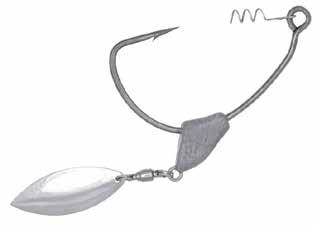
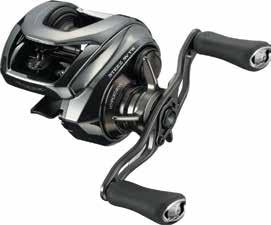

OMTD is an Italian brand new to Australian shores offering a range of innovative jig heads. OMTD designs are inspired by the increasing evolution of fishing lures.
The Big Swimbait Bladed Hook is great for weedless rigging applications on swimbaits, shads, and big soft baits. It’s equipped with a highly visible and attractive blade that enhances vibration. The blade is rigged on a swivel and positioned on the weight at a proper distance from the hook. The weight shape increases the attractive movement of the bait which is solidly attached through a spring keeper. Perfect for fish9ng big baits this winter for Murray cod and barra.
ejtodd.com.au
Introducing the Samaki Redic SF110, the latest addition to the renowned Redic series with a diving depth of 0.8 meters (2.5 feet) and a weight of 16 grams. This floating jerkbait lure is ideal for fishing in shallow water environments and versatile enough to be used throughout Australia. The SF110 features the cuttingedge LongCast Magnetic Transfer System, ensuring impressive casting distances and precise accuracy. Its robust construction includes a one-piece stainlesssteel wire-through design and sonic welding, providing unmatched strength and durability. Equipped with Decoy YS-81 treble hooks, the SF110 guarantees superior hook-setting power and reliability, backed by the world’s number one hook brand. The signature Redic super durable paint finish not only offers a stunning visual appeal but also withstands the harshest conditions, ensuring longevity.
samaki.com.au







100% Fluorocarbon leader with high sensitivity and abrasion resistance while retaining high shock resistance. Triple resin processing and parallel spooling give this leader the tenacity to endure the toughest fight.
Available in:
50m spools 12lb to 50lb 30m spools 60lb to 100lb



A sinking PE line with a specific gravity of “1.48” This is achieved by incorporating 4x ULT-PE stands and 1x high specific gravity core material. This improves lure control when using sinking lures and has less influence from the wind and tide.
A special masterbatch of Nylon gives this leader a high breaking strain and high tenacity to endure with low water absorption. Supple and easy to handle, it enhances knot perfection. Excellent shock absorption on hook set.
Available in: 50m spools 4lb to 150lb Available in: Colours: Pink & Olive


Now’s the perfect time to add a pop of colour to life with the Revelry MQ FC and Revelry MQ HD spin reel. Taking inspiration from the original Certate release, Revelry consists of two distinctive and very different models, built on two completely different frames and built with different styles of fishing in mind. A lightweight FC ‘Finesse Custom’ series caters for the finesse angler, while the robust and durable HD ‘Heavy Duty’ model is tailor made for anglers that require the ultimate in strength and power.
Revelry MQ HD is the workhorse of the Revelry range and is built on a sturdy aluminium Monocoque body (MQ). Revelry HD is strong and robust and is equipped with a high-end forged machine cut aluminium Tough Digigear to give unmatched rotation power and torque. Revelry MQ HD is available in four deep spooled sizes (2500D, 3000D-C, 4000D-CXH, 5000D-CXH)
Revelry MQ FC is the ‘Finesse Custom’ offering, crafted from a single piece Monocoque (MQ) Zaion frame making Revelry MQ one of the lightest spinning reels in the Daiwa line up. The Zaion MQ body is equal parts strength and weightlessness while a fully forged machine-cut aluminium Tough Digigear drive delivers buttery smooth rotation and a long-lasting drivetrain. Revelry MQ FC is available in four shallow spooled sizes (2000S, 2500, 2500S, 3000). Spin reel perfection has new looked or felt this good. daiwafishing.com.au


Daiichi hooks from Japan has released a superb new range of Heavy-Duty Death Trap treble hooks due to demand from anglers looking for a heavier gauge of the highly popular Death Trap trebles. The Daiichi HD Death Trap trebles feature rounded bends for better hook up rate retention as well as oblong eyes which allows for a better swing on the lure. The Daiichi HD Death traps are a 3X gauge so they will easily penetrate even into the tough mouths of species like Bream. These hooks feature Daiichi’s legendary Chemically sharpened hook process, so every hook is razor sharp straight out of the pack. These hooks are a must have replacement for the serious lure angler. jurofishing.com
The Vexed Bottom Worm Mutsu might be a little bit different to anything you have seen before, but that’s because Vexed has only just created this new concept off the back of its extremely successful big brother The Bottom Meat. The Bottom Worm Mutsu has been designed as a micro version of the Bottom Meat, but for lighter outfits and smaller inshore species. It can be used on its own, or on the bottom of a paternoster rig as a fish-catching sinker. 70% or more whiting are caught on the bottom dropper hook of a traditional paternoster rig. By using the Bottom Worm Hybrid as the sinker, you now have two prime fish catching baits down on the seafloor. During our testing sessions for sand whiting and king george whiting, we caught more fish on the Bottom Worm Hybrid fished as the sinker than we did on the bottom dropper hook. With a super sharp BKK Mutsu circle hook and a durable, stretchy little scented Vexed Bottom Worm, this will present small soft baits such as worm, pipi, squid, prawn and mussel perfectly. Available in sizes from 3.5gm- 130gm and hook sizes from #10 to #1, Bottom Worm Hybrid’s will suit most fish species from boat, beach, estuary, jetty or river bank. Bottom Worm Hybrid’s can also be jigged through structure or slowly hopped across the bottom without bait for many inshore species such as bream, flathead and whiting.
vexedfishing.com.au






Introducing the latest addition to the Maria Pop Queen lineup: the Pop Queen 200. Maria’s beloved saltwater popper has been designed in a larger 200m version for uncompromising performance, this new size brings enhanced capabilities to your fishing experience. With its hefty 100g weight, it excels in stress-free casting and action, especially with heavy tackle (PE 6 to 8), overcoming the limitations of its predecessors such as the F160. Like all lures in our Pop Queen series, it adapts to changing conditions, offering a range of enticing actions. Experience its popping action, creating fine bubbles to lure in fish, or enjoy its bubbling action during underwater retrieval. And when using the rod tip, it tantalizes with a sliding action akin to a diving pencil, enticing even the most hesitant of bites. ejtodd.com.au




The Samaki Vortex Iron stands as the ultimate spinning lure, meticulously designed for targeting a variety of species. Whether you’re casting from the rocky shoreline, a boat on open waters, or the beach into the surf, this onepiece construction, injected stainless steel spinning lure offers exceptional performance and accuracy. Its streamlined design and impeccable balance make it a precision tool for long, accurate casts. The lifelike motion and realistic appearance of Vortex Iron mimic the natural prey of your chosen target species, making it an irresistible temptation. What sets it apart is the printed finish, ensuring longevity and resilience, even in the most demanding angling conditions. With this versatility and cutting-edge construction, you can confidently pursue your desired catch from any location.
samaki.com.au
The Hydro Monster Shot is the most versatile hard bodied lure on the market. It can be fished from the surface to the bottom, and everywhere in between. It’s a heavy weighted lipped stick bait, that falls in a horizontal posture, with a side-to-side wobble that perfectly mirrors a dying baitfish. On a straight retrieve it has wide wobble action, when jigged or twitched it has a sharp darting action and when burned across the surface, it has a skipping action that resembles a fleeing bait. Through wire construction, a durable lead filled body and triple strength saltwater grade treble hooks, quality throughout. It comes in 6 colour patterns and 3 sizes to cover everything from mackerel, bonito, tailor to tuna species. The thin profile mirrors a variety of bait fish with the added weight to make extra-long casts. Available in three sizes 95mm/40grams, 110mm/50grams & 125mm/60grams.
tacspo.com.au






























































































































The Tackle Housing Rolling Bait is a sinking lure that has a plastic bib situated on the back of the lure. The Rolling Bait, as the name suggests has a ‘rolling’ action, instead of a traditional vibration seen on most lures. The lure swings side to side with a horizontal swimming action that is almost incomparable to any other lure on the market. The new 55mm Rolling Bait has the same great action and features of the original but in a micro size that’s perfect for targeting bass, bream, estuary perch and trout feeding on smaller prey. They come in a great range of detailed colours. Made In Japan. gladiatortackle.com.au



Dingle Dangles have been a big hit with the surf fishos! What’s a Dingle Dangle? Well, it has been designed by South African Surf casters to create a floating, berley bait holding device. Wrap a juicy fillet bait around the white foam dingle Dangle and wrap in Vexed Bait Cotton to create a juicy, smelly bait offering! The Dingle Dangle will also keep your bait off the Bottom away from pesky rays! The Vexed Dingle Dangles are available in 4.5cm,6cm,8cm and 10cm lengths with 3 per pack. They are also available rigged with the Vexed Mutsu hooks in 4 key sizes. To Add to this range, Vexed has also as part of their expanding rig range, added in a Dingle Dangle Pulley Surf Rig, available in 5/0-8/0 sizes, these have been built to be fished straight out of the packet and ready to go.
vexedfishing.com.au
Yo-Zuri’s Pins Minnows Series has been a top seller worldwide for over 2 decades! The Pins Minnow floating lures series is offered in a variety of natural colours and patterns to tempt even the most cautious trout. They incorporate a durable ABS Resin lip to get down over the structure and in the strike zone. These extremely versatile baits cast very well for their size, they are perfectly suited for stream and lake fishing. The Pins Minnow Series can be cast or trolled producing a tight wiggling action that attracts a wide variety of species to strike. Available in two sizes 50mm/2 grams & 70mm/4 grams.
tacspo.com.au

Lake Eppalock’s fish habitat just got a whole lot better thanks to your recreational fishing licence fees and Ozfish Unlimited.
The Ozfish team and contractors used the $80,000 grant to install more than 50 logs and root balls, thus creating more habitat for iconic Murray cod and golden perch. The logs and root balls were attached to existing tree structures in the lake to avoid movement during periods of flooding.


This additional fish habitat will provide homes for some of the 3.3 million Murray cod and golden perch we’ve stocked over the last five years. Go get ‘em!

The Imperial USA fly rod delivers elevated performance at a decidedly down-to-earth price. Handcrafted exclusively in the USA, these rods are without equal in performance and value. The Imperial USA Fly rods feature a dynamic blend of SCIV carbon mixed with premium SCII carbon to product a high-performance blank. Each rod features a uplocking machined aluminium reel seat with wood insert and premium cork grip handles. The rods feature a Kigan Master hand 3D Stripper guide with SeaGuide snake guides with PVD coating for extra hardness and increased smoothness. The Imperial® U.S.A. fly rods are available in two piece and four-piece models from 3 to 6 weight options and come with rugged rod case with handle a divided polypropylene liner. The rods are made in the U.S.A. and come backed by a 15-year Unconditional Warranty. Trout anglers will appreciate the quality of the build of these fine rods.

Now is the perfect time for a mid-year fishing getaway and the Wilderness X travel rod series from Daiwa is the perfect rod to pack. Wilderness X takes the popular 3-piece models from TD Hyper and TD Black and upgrades them into a single dedicated travel series with more models and more joints than ever before. A true dedicated travel-pack rod series, Wilderness X models feature four and 5-piece joint construction to significantly reduce packed length, allowing them to easily fit into backpacks and small suitcases for local or international travel. Daiwa’s V-Joint technology eliminates the old-school flat spots and weak areas associated with multi-piece rods, producing actions akin to those of single piece rods. Packability and portability doesn’t come at the expense of performance and quality with HVF Nanoplus and X45 blank technology, and stainless-steel Fuji Aluminium Oxide Ring guides deliver classic Daiwa strength and performance. The range features six spin and three baitcast models. Meaning whether you’re flying into Tassie for a sneaky trout session, heading to the NT to chase barra and toga or taking a long-haul flight to the US or South America to catch tarpon there’s a model in the Wilderness X range that has your baggage tag and name on it. daiwafishing.com.au

In an ocean of mediocrity, countless rods promise the moon, only to deliver a fish tale. The Saltan is an exception — redefining what an offshore rod can be for those who believe ‘weekend warrior’ is a title earned, not given. Skilfully crafted with premium composite blanks, each Saltan model offers unparalleled action. Further reinforced with X-Weave carbon technology in the butt section and equipped with legendary Fuji components, this rod promises both premium performance and rugged durability. The Saltan is available in three specialized sub-series: Reef, Boat, & Jig, ensuring no matter the challenge, you’re armed to the teeth. samaki.com.au



Introducing the Edencraft 6.0 Offshore, the ultimate trailer boat for both bay and deep-sea adventures. Renowned for its exceptional stability and ergonomic helm layout, this vessel ensures a smooth, predictable ride every time. The 6.0 Offshore has been designed to have everything a hardcore fisho needs on board, in its right spot and available when needed. Side pockets, live bait tanks, rod holders, dash controls & deck space have all been designed with the fisherman in mind. So when the reel starts screaming and the pressure is on, you can count on your setup. The Edencraft 6.0 Offshore strikes a great balance between the performance of larger boats and the versatility of smaller boats. This means freedom on the water, ease of transport and storage on land. The Edencraft 6.0 Offshore is a boat that redefines the limits of trailer boat performance. edencraft.com.au

The Tackle House Feed Shallow is a 155mm floating jerkbait that features a strong rolling body action with a natural head roll that sets it apart from other shallow running jerkbaits. The sides of the body are almost flat, and the vivid flashing effect is an effective strike trigger. It’s a highly responsive jerkbait built with Tackle House’s K-TEN system equipped with magnetic tungsten to provide an overwhelming cast distance. It’s a big lure with a highly durable construction and a finessed response that anglerd can use to target big flathead, mulloway, jacks, threadfin salmon and barra. It comes in a great range of beautifully designed paint schemes that feature detailed scale patterns and holographic reflective finishes. Made in Japan.
gladiatortackle.com.au

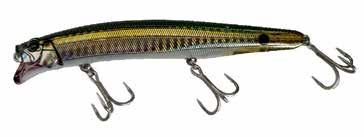
Recreational fishers can once again set their sights on catching the much-loved freshwater Murray spiny crayfish when the three-month open season begins north of the Great Dividing Range on 1 June. Victorian Fisheries Authority (VFA) CEO Travis Dowling said there are many popular spots in northern and north-east Victoria where crays can be targeted, primarily by boat-based fishers, using labelled hoop nets or even just a piece of meat on a length of string. VFA Fisheries Officers will be patrolling hotspots this winter, with a particular focus on the handling and measuring of spiny crays to ensure they’re within the legal-size range of between 10cm to 12cm. Tatura-based Supervising Fisheries Officer Daniel Gleeson said the measurements needed to be taken of the main body shell, known as the carapace length, defined as being measured from the rear of the eye socket to the near end of the shell before the tail. You can grab a free Recreational Fishing Guide from your local tackle shop, download the free VicFishing app or head to vfa.vic.gov.au/fishingguide for more information on the bag limit of two crays, the statewide possession limit of four per person at any one time and permitted equipment. vfa.vic.gov.au/fishingguide



There’s always more to learn about this humble speciessuch as why ‘peas’ are on the menu.
Words: Steve Cooper Images: A full crew
King George whiting are well-spread, ranging from southern New South Wales, through Victoria and South Australia to the southern reaches of Western Australia. This species is proof that when it comes to fish popularity, taste can override appearance, size and colour. It isn’t that whiting are easy to catch; these fish can be frustratingly finicky, making them difficult to hook, provided that is they are in the mood to feed.
Once hooked, whiting put up a solid fight. However, the reality of fishing for King George whiting is that it is about food for the table, something I rate as an age factor. The older you are, the more appreciative you become of food values and taste in fresh fish. Catch and release is for less savoury relatives.
In their life cycle, King George whiting larvae spend three to five months drifting across the ocean from South Australia before they reach Port Phillip Bay and Western Port in Victoria. Wind and current play a major role in determining the success or otherwise of whiting. Victorian researchers found the strength of westerly winds important: the stronger the winds, the more whiting larvae enter Port Phillip Bay. Also, the strength of the eastern coastal current (an offshoot of the Leeuwin Current) that delivers warm water east from South Australia plays a role, as the warmer the ocean water is, the better the survival of the whiting larvae.
The abundance of whiting fluctuates from year to year: in Victoria, for example, catches were plentiful in the late 1980s and again in the late 1990s, but in 2006 catches were lower. More recently, during Covid, whiting captures were plentiful, but this year catches are down in many waters. Once they enter bays, whiting are dependent on seagrass habitat, which generates food and provides shelter. In general terms, the more seagrass growth there is, the more whiting there are.
Just when you think you know all there is to know about a species, something unusual crops up. It can start out as a seemingly small aside and grow into a much bigger issue. And so it was with a chance meeting with Ross Winstanley at a Corio Bay boat ramp, near Geelong. Ross is a marine biologist by trade and knows a thing or two about fish. He also loves to fish; in fact, Ross is on the water three to five mornings every week, weather permitting.
It turned out that Ross had been doing well fishing for whiting along the edge of the spoil ground in Stingaree Bay. On this morning he had been fishing with Queenslander Peter Stoneley and the two had caught a dozen or so whiting to 39cm on squid and pipi cocktail baits. It was a below-average catch given that a few times of late he had bagged out.
Ross set about cleaning the catch, tossing the frames to the seagulls, putting the fillets in a bucket of water and the heads of the whiting into a supermarket bag I just happened to have with me. As we were talking Ross mentioned having a few fish recently that had peas in their stomachs and, while he had heard of experienced anglers using peas as berley for whiting, was unsure of the merits of using them. Ross said whiting frequently regurgitate small green ‘slugs’ that curl up and look like peas. His attitude to peas as bait changed after cleaning a fish and finding five green lumps in its intestine that turned out to be undigested peas.
That peas are effective as bait on whiting is beyond question, but why whiting – a finicky feeder at times – took peas was a mystery to me for many years. I just accepted there were some strange dietary fads among saltwater fish. The mystery started to be solved when former Queenscliff charter boat skipper John Joubert emailed me: “I regularly check the stomach contents of whiting, and of course worms are the most common stomach content followed by a green slug the size of a pea,” said John, adding that these same slugs are what cause the snail trails on the sand underwater.
I told Ross about John’s suggestion, so he thought he would take the matter further and contacted Greg Parry at the Queenscliff Marine Science Centre for an opinion and forwarded Greg some photos I had taken of the curled-up slugs that had come out of the whiting. Greg’s response, and this is where the going gets heavy, was that he thought the green slugs might be the “proboscises of echiurans”, adding that “the groove in the middle of some bits in your photo are suggestive of this, but I still consider this a wild guess. The proboscises of echiurans sit
on the surface where they are vulnerable to something that might bite them, but they detach from the animal which is usually very well buried and unlikely to be eaten.”
In case you didn’t know, a proboscis is like the trunk of an elephant, or even the human nose. In the insect world it can be any of various elongated or extensible tubular processes, like the sucking organ of a butterfly or (and more importantly) the oral region of an invertebrate. As for echiurans, Ross sent me some text on the creatures, which, as it turns out, have the unpronounceable scientific name Anelassorhynchus porcellus. Also known as spoonworms, the animals are 40 to 100mm long, dark green and have elongated, oval-shaped bodies. The bulk of the animal is buried, and it feeds via an appendage that protrudes above the seabed. Each appendage (proboscis) has mucus that is used to trap dead organic matter and funnel it down to the stomach of the animal.
What happens then is that the whiting, which feed on the bottom, see green ears poking out and nip them off, and when anglers clean their fish, they end up with small green parts of the creatures that have closed over like worms. So now you know what those green peas are. But the mystery doesn’t end there. Where do these creatures come from? I have dug sandworms, when it was legal to do so, and pumped Bass yabbies among the weed beds of Port Phillip Bay and have never come across these creatures, and Ross said it was the same in his experience. In some parts of the bay, whiting anglers put red tubing or beads on the lines above the bait in the belief it will attract more bites. Perhaps they should be working green beads and tube instead of the popular red versions?




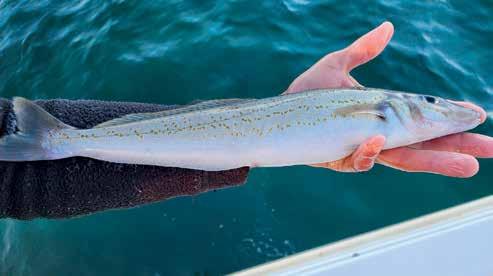
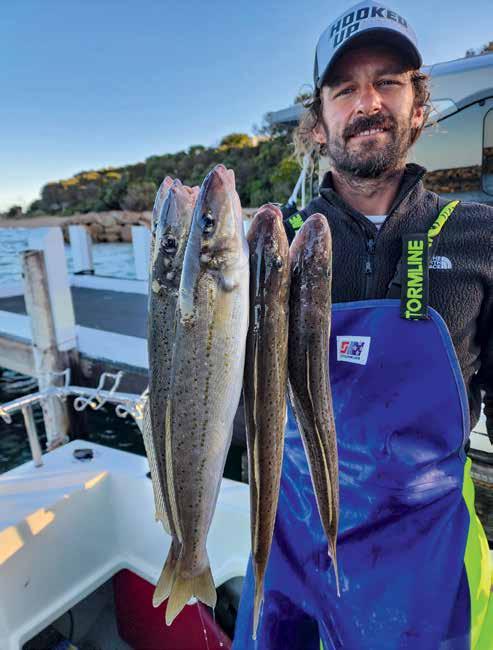


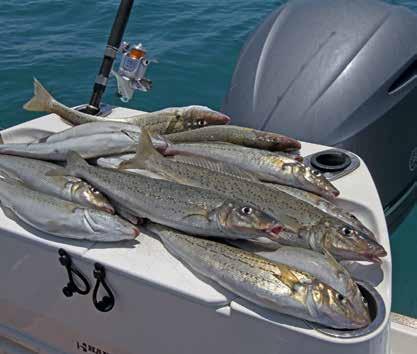

The first thing you need to organise is your boat. First and foremost, your anchor and chain must be absolutely guaranteed to hold you, even in 30-knot conditions. The bonus is on calmer days you can anchor with a short rope to make boat positioning easier. Most often when you anchor, the tidal flow will direct the boat more than the wind. However, in areas where there is less water flow, a short anchor can be a definite advantage to stay on the fish zone and negate the wind factor.
Always approach shallow marks quietly, trying not to motor over the bait zone. Approach in a semi-circle to the anchoring point, drop the anchor then allow the boat to swing back with the tide. Whiting can be easily spooked, particularly in shallow water, so it is best to avoid continual re-anchoring in the same area to get your boat in the right place to fish a bank drop-off or hole. Noting the lie of other boats at anchor before putting your anchor down will help you work out your likely angle. I always try to fish wind and water in the same direction.
Most anglers use 3-5kg outfits consisting of a threadline reel coupled with a fine or nibbletip rod. My preference is a nibble-tip rod and this suits shallower waters using sinkers to about 3oz. Where tides are stronger and heavier sinkers (up to 6oz) are required, add some low-down grunt but try to keep the tip reasonably fine. Reels are probably the least important component. Many old hands prefer to handline their fish. The rod is still used to
control the fish, but instead of winding the line onto the reel, it is pulled through the guides and allowed to coil in a bucket at the angler’s feet. Once the fish has been landed and fresh bait put on the hook, the line is recast; distance is controlled by the amount of line left coiled in the bucket. In this way, and providing the angler is accurate, the bait should land in the same spot the last fish was taken from.
That method was developed when centrepin reels were all that was on offer. These days I prefer to use a reel and take my chances on being able to drop bait back in the same spot. Reel choice depends on workload. My preference is 2000 or 2500-size reels spooled with about 5lb monofilament or 10kg braid. Leader material should always be monofilament.
Everywhere you fish for King George whiting there seems to be locally sourced bait and adaptations to methods that work better. The most common bay whiting rigs are variations of the paternoster style (albeit running paternoster), the main thing being that your bait is below the sinker.
In this instance, the sinker is set on a dropper leader of about 15cm with sinker size varying with tide. Braid reduces the need for superheavy sinkers in strong current, but you will need to make a judgement on weight. Even with braid, it is common to employ six ounces (170g) in fast tidal flows, like those you find near bay entrances. In strong current, leaders tend to be longer, up to 2m; in slower water
you will get away with a leader of a metre or less.
An alternative rig is the running sinker. Hook size is the same, leader length is stretched to 30cm, and again, the amount of lead is governed by conditions. In strong tidal areas a paternoster / running sinker rig with a single leader of up to a metre long is sometimes the most effective method. The sinker is set on a short leader and the leader tied to a swivel above the sinker swivel and allowed to run.
Hooks to use are personal choice. Circle hooks work well. My preference in the Mustad Wide Gap (Kahle) or Gamakatsu Shiner Circle from No. 4 to No. 6. Hooks up to 2/0 in Suicide patterns will hook whiting, but the offset can reduce hook-ups.
Baits vary with locality: I like fresh squid as a base, and then top this with a piece of pilchard, mussel, pipi (cockle) or sandworm. Pilchard strips also work well without any additional bait, and there are anglers who swear by Bass yabbies (nippers).
Berley will help. Crushed mussels, bread and chicken pellets in combination work well while pilchards are also a favourite additive to a berley mix. When used in conjunction with berley, small strips of pilchard on the hook will sometimes out-fish all else. Some anglers simply throw their empty mussel shells over the side, the thin hard sinew that lines the edge of the shell being enough to







What sets Gosen apart is their commitment to quality from start to finish. These exceptional braided lines are meticulously manufactured in Gosen’s own facility in Japan. This ensures that every step of the production process, from selecting the finest raw materials to weaving and testing, is executed with the utmost care and expertise.
Gosen braided lines are designed to meet the rigorous demands of anglers who seek uncompromising strength, sensitivity, and casting performance. The result is a series of braids that deliver a seamless fusion of technology and tradition, offering anglers an edge in their pursuit of trophy captures.


keep the fish around. An advantage of this system is that other unwanted fish such as leatherjacket and toadfish are not sufficiently endowed to feed on this morsel and leave the scene. In deep water, say 8m, or fastflowing water, attach a berley bucket rope to the anchor spit so the bucket can drift back under the boat, be away from lines and the fish retrieval zone, but still feed berley into the bait zone. Of course, the berley bucket or cage must be sufficiently weighted to reach the bottom in the tide.
Whiting like to forage in areas where there are weed beds broken up by intermittent patches of sand. A top whiting fisher can be distinguished from the rest by his ability to lob his bait into a sand clearing, which is where the fish will be found feeding. In deeper water the same rule ap¬plies, but there are exceptions and one of these is along the edges of channels where larger whiting can sometimes be found feeding on ledge formations. Nevertheless, they will never be far from rubble, reef or weed.
What depth to fish is a common question asked by beginners. A good rule of thumb is three to six metres as a starting depth. Finding fish may mean moving about. Move when you are not getting a bite and continue doing so until you find the whiting. Some areas produce best at different times of tides, either flood or ebb, but lack of moving water can send whiting off the bite. Anglers should plan to fish when a tide is running, preferably between high and low water.
The window of opportunity for a hot whiting bite may last only 30 minutes so it is good management to be about 30 baits ahead


for when the fish come on. The last thing you want to be doing when the whiting come on is preparing bait. And don’t lose time playing around with flathead – flip them off if they are mixed with a whiting bite and get straight back in. Remember, this is about catching whiting. It pays to have hand towels available to remove fish slime and bait from your hands when the fish are on.
Try to work with your fellow anglers to ensure bait is always in the water at the strike zone. This can be critical on shallow marks. I always like to landmark my bait placement and continue to place it where I caught the last fish.
There is no great secret to hooking whiting. Feel a bite, move the bait slightly and the chances are the take will be hard. Big whiting take baits with more certainty than smaller fish, which can be finicky and more inclined to suck than swallow. If you have a good bite and miss it, change your bait – whiting don’t like seconds as much as some fish.




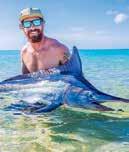












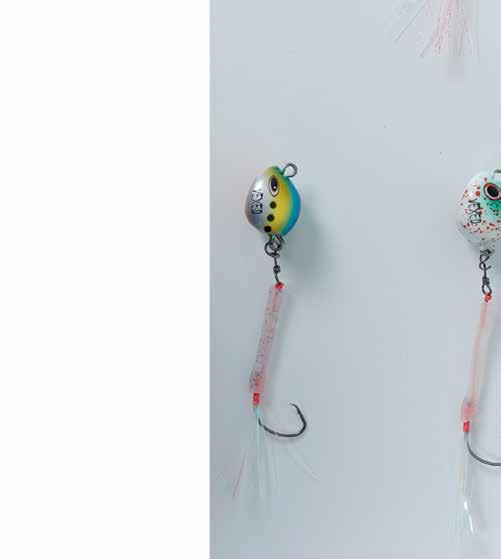


We are giving away $1000 worth of Insalt fishing gear every month for the biggest or best capture on an Insalt Finesse Explorer or Estuary Explorer rod voted by our followers.
To enter your catch just post your photo and tag us on Facebook In-Salt Fishing and/or Instagram @insalt_fishing and use the hashtag #insaltnoodlerod
Please note: Video evidence will be required if you are the winner!
We don’t sell Insalt rods to the public so check your local tackle store for our products.
Terms
conditions
1. You can enter as many times as you like but once you enter a catch it can not be entered again in another month.
2. Only these rods can be used in the comp Insalt finesse explorer 5’6 spin, 6’6 spin and 5’6 overhead or our previous model Estuary Explorer.
3. Insalt will provide nominations at the end of each month. The winner is voted by the public.
4. The prize is voted on the biggest or best catch.
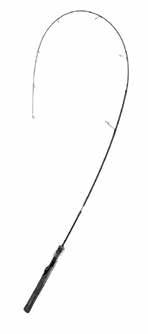
5. Anglers can use line above the recommended rod 1-3kg rating but it’s not recommended and will forfeit warranties

Trolling for trout in alpine waters forces a change of tactics that pays dividends.
Words & Images: Dean Norbiato
As with any trip to a new destination, there is always a cocktail of anticipation and excitement that bubbles away inside, and Jindabyne was no different. Its bigger brethren, Eucumbene Dam, roughly 30 minutes down Kosciuszko Road, is a place where I’ve spent more icy mornings than any other trout dam in this country.
While Jindy and Eucumbene do share some similarities they are also poles apart, like Sydney and Melbourne. For instance, when both waterways were dammed back in the 1950s and ’60s the good people at Adaminaby decided to have all 102 of their houses uprooted and moved 10km away, while the industrious and less sentimental folk at Jindabyne opted to have new houses built for them 2km up the road.
A bit like the founding fathers of Adaminaby, we have a rusted-on affinity and sentiment about fishing the Euc. So much so that we have given names to exact trout trolling runs. We have also renamed whole bays in line with the fishing activity they have provided over the years – my personal favourite being big bait brown bay. Euc is like slipping on a pair of well-worn boots.
Having kept a close eye on Jindy over the past few years and its fish-catching prowess, this necessitated the need to shake up our annual trout trip and journey further into NSW’s Snowy Mountains. To get this trip over the line we extended the invite to our kids and better halves, which they accepted, as there is a lot more to see and do in Jindabyne than Old Adaminaby. That is yet another stark difference between the two dams. Eucumbene feels almost isolated compared with Jindabyne, with its population of about five thousand scattered around the dam’s 30 square kilometre perimeter. The population number also swells during the peak mountain bike and snow seasons, as it’s the tourism jewel in the Snowy crown.
But let’s get back to the trout fishing, that’s why you’ve read this far. At first sight I was gobsmacked at how picture-perfect the dam looked for trout fishing. I have always said fish-producing dams for certain species all have one thing in common.
They allow, even novices, the ability to effortlessly employe the most popular lure fishing method with ease. Think, Windamere’s sloping banks to hop lipless crankbaits down for yellowbelly, or Copeton’s countless rocky outcrops and drowned timber, seemingly purpose-built for targeting Murray cod on swimbaits and surface paddlers. For Jindabyne, it had countless kilometres of gently sloping banks dotted with protruding points, with most covered in yabby-hiding boulders. I was figuratively licking my lips at all the possible trolling runs we could take.
As it was the afternoon, and the sun was gradually starting to dip towards the
mountains, we decided to try our luck in shallow water. We strapped on a pair of the new 3ft AC Slim Invaders, an Oar-Gee Lil Ripper minnow and the omnipresent 13.5g Tassie Devil winged bait.
Looking down at the depth sounder as we rounded our first point in Hatchery Bay, what first caught my eye was the temperature of the late autumn water. It sat a shade over a tepid 13C. Usually we look for a single-digit figure around this time when targeting the banks, so with that intel we knew the chance of them being up in the shallows seemed slim. After close to two hours that realisation crystallised, with nothing more than a halfhearted tap on the Tassie being our only action. So, instead of going even shallower, as we traditionally do when the sun fades behind the hills, we moved out from the bank to twenty feet.
With that, we changed our baits, keeping only the winged Tassie as the surviving member of the shallow water squad. On went an 18ft AC Slim Invader and two 20ft Stuckey’s divers. Before the entire spread was even set, the wailing drag of the 2500-sized Shimano Sedona sang its favourite tune. Leaping into gear with the muscle memory of an Olympian, my brother-in-law, Jethro, patiently nursed aboard our first quality brown of the trip. The perfectly marked 55cm specimen took a liking to the red and black Stuckey’s lure that was set as the deepest rod in the spread.
After a few back slaps and a quick photo, we stealthily navigated the boat in a big wide arc back around to the start of the run. Managing the adrenaline and excitement that a good fish injects into the boat is a skill I have tried to hone over the years. Rather than letting the excitement dictate our actions and noisily revving up the 60hp Yamaha and potentially
scaring the resident trout, we cautiously cruised back to the start and repeated the exact same run. Never leave fish, or scare fish if you want to find fish and catch fish. I’m sure that’s the saying, isn’t it?
After a couple of smaller, feisty rainbows, all out in 20ft, we called it a night and headed back to our accommodation that overlooked Stinky Bay.
The next morning, and being suckers for punishment, saw us again tie on the shallow diving minnows and head gung ho into the shallows. Yet again, two hours quickly melted away with less rod action than a 40-year-old virgin. After the morning coffee, courtesy of the Jetboil, we then tied back on the deeper divers and headed for the 20 to 30ft range. Thinking it was just going to happen, you could almost anticipate our dismay when we could only wrestle aboard a brace of barely legal ’bows for the morning.
During the day I decided to tap into my contacts and messaged a bloke who I knew lived up this way. He was quite forthcoming with info and steered us towards Creel Bay, which sat at the mouth of both the Thredbo and Snowy rivers. As the trout hadn’t run upriver yet, and as there was insufficient rain, they should be absolutely stacked in this area. Unfortunately for us, while the fish finder lit up like Christmas, those fish were very hard to tempt, as it seemed they had other things on their minds. Rolling with the punches, we then turned our attention under a fading sun to the East Jindabyne area. I’d intercepted some information on a Jindabyne fishing Facebook page about this rocky area being productive on the troll. As we arrived, we saw a number of bank-based anglers drowning












baits in among the boulders. Eerily, as we trolled exactly adjacent with the first bait fishos, in 25ft of water, the old man’s Sedona drag burst into song. After a few nervous moments at the boat, courtesy of a well-oiled net man, we scored our second 50cm+ brown for the trip, this time on the gold and red Stuckey’s lure.
Looping back around and the diver got smacked, again, directly in front of the same bait fishos. Reading the room, we opted to continue on our run, under the staunch glare of the somewhat agitated bank anglers, rather than looping back around as we were accustomed to do. With the deeper diving baits out the back it became even more important to watch the bank structure so you didn’t pile-drive your baits into shallower bottom. The one distinct factor of a Jindabyne bank was the amount of points it possesses. They will sneak up on you worse than a hangover on a Sunday. So it became more important to anticipate when the points jutted out into the lake and eroded the magic 20 to 30ft bracket. If you didn’t take a wider berth on these points you would be forever reversing back up to free baits caught on the bottom.
It also became just as important to follow the contour of the point back towards the bank as you were coming off its apex. Fail to do this and you would see the boat navigate off the point into water as deep as 60ft.
Flailing in this depth off a point was a missed opportunity as you wanted to maximise the time your bait spent in the 20-25ft range. This is where my father, Denis, really stepped up and his 20-plus years skippering this very tub meant we stayed in the all-important strike zone for longer.


Finishing off the session saw three more solid fish and a handful of smaller rainbows falling to slow-trolled minnows. This included my father-in-law, Colin, nailing the best shallow water brown of the trip, a healthy 50cm specimen that ate his 4cm Oar-Gee Lil Ripper.
Rolling out of bed for our final session and we were greeted at the Widows Inlet boat ramp with something none of us expected. At minus one and frost on our beanies, we saw a chirpy Kiwi lad in shorts and thongs.
I couldn’t resist the obligatory comment about why he was wearing shorts in near-freezing conditions. He quickly retorted: “I’m over from NZ and didn’t think we’d be going for a fish, so I didn’t pack pants, but I’d never miss an opportunity to tune a trout.”
Not sure how long he lasted in the arctic conditions, but we did not see him or his skipper again. Guessing the call of the house heater, or frostbite, got him first.
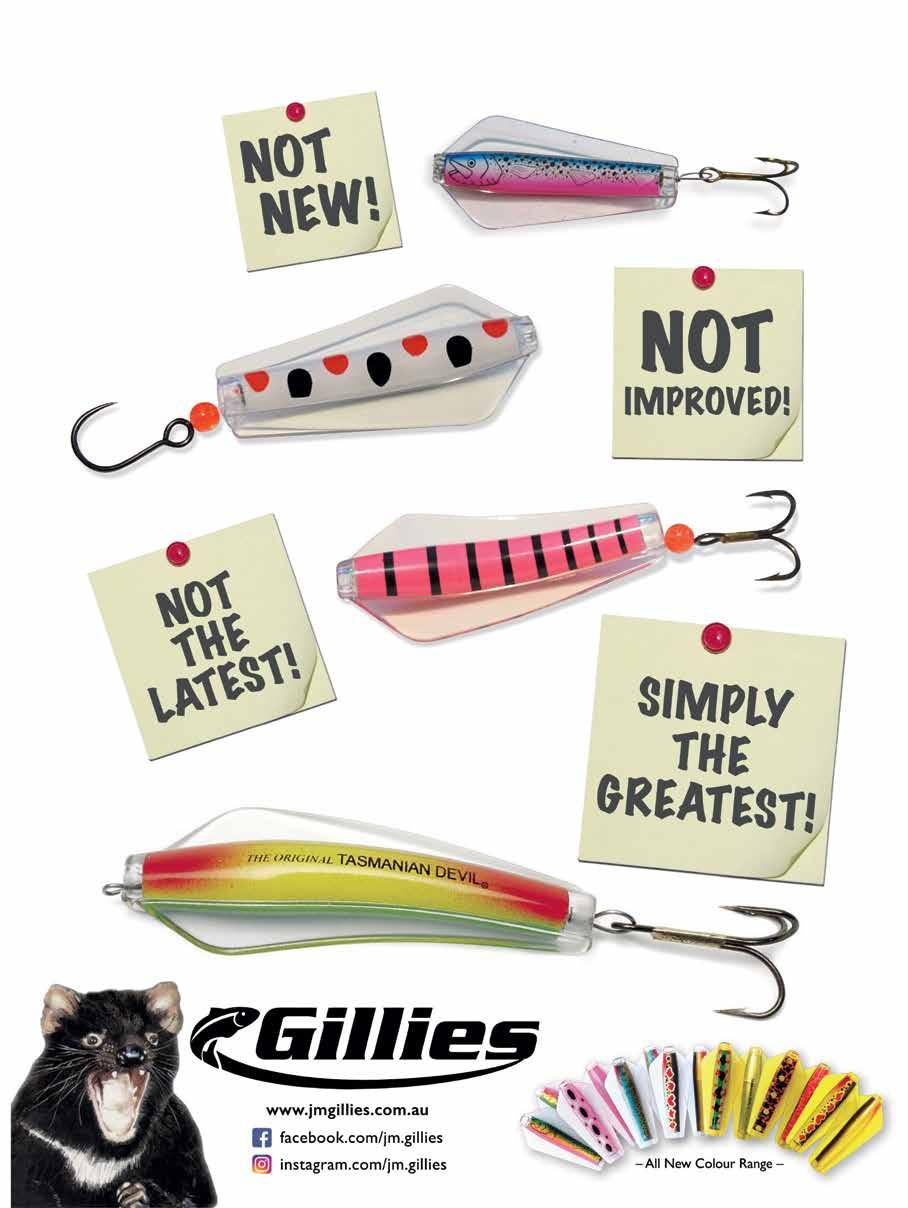
Out on the water and we headed straight to the East Jindabyne area. In almost the identical spot, and I mean identical, where we scored action on back-to-back passes the day before, we again heard the Sedona’s drag sing. This was an eye-opener for all of us, as we had a strong reference point because it was directly in front of the stinkeyed bait fishos.
While it was mostly done by a keen eye rather than electronics, it was amazing how perfect the troll run needed to be to score a strike. As little as five metres either side and you would pass through with no action at all.
We were unsure what was going on under the water, but this small patch of water was clearly a keen feeding zone. In a onehour period we made upwards of a dozen different passes along a short 100m stretch.
On more than half the occasions our rods buckled over and sent the boat into action. The trick to tempting the trout to strike, it seemed, was to have our baits in the exact right corridor and swimming around a foot from the bottom, just like a fleeing yabby.
While I don’t want to get too methodological, it required an exact science, and if you had any elements out of whack, like speed, location or depth, you would kiss your chances goodbye.
This yabby imitation theory was somewhat validated when we took a couple of trout for the smoker and examined their stomach contents and found then chock-full of crustaceans. Nothing too revolutionary in knowing trout eat yabbies in our alpine lakes, but every morsel helps and it did aid our strategy and eventually nudge us in the right direction.


Pulling the tarp over the boat for the final time as I stared back over the dam, I finally recognised why Jindabyne was such a formidable foe to Lake Eucumbene in the alpine trout slugfest. All up, we had fished some magical water and boated more than 30 fish for the trip, keeping only a few for the smoker. Our wives and children had an absolute blast exploring Jindy’s cosmopolitan lifestyle, while also ensuring our credit cards didn’t gather any unwanted dust.
Its glitzy party-like town centre, countless shops and eateries, all only a stone’s throw from some of the country’s best trout fishing, sees Jindy land more than a few superficial blows in its title fight against its bigger alpine brother.




















ST.Croix Rods have been handcrafting the Best Rods on Earth® for the past 75 years manufacturing rods in North America. We strive to offer the most advanced Rods using the finest materials and give the angler a true angling experience! Our passion is your passion and that’s why we offer the





We didnt make any compromises when choosing and fitting out our latest vessel.


A boat is an integral aspect of running a successful fishing media company. It’s essentially a second office that we use to create all our content, test tackle, use as a camera platform to shoot other boats and – of course – film our Hooked Up Video series. As we cover all aspects of fishing on our various media platforms, it’s always been a challenge finding the right boat to handle a variety of fishing styles. We started off back in 2014 with a Haines Hunter 525 Prowler, which had a good little centre console and was a jack of all trades – but master of none. After a few years of getting wet, cold, sunburnt and short on space, we moved on to a Haines Hunter 595 Offshore cuddy cab. Targeting snapper, gummies, whiting and tuna was awesome, we had shade via a Targa, safe places to stow expensive camera gear and we were dry, but we weren’t covering the estuaries, lakes and rivers. So, we then looked for a crossover vessel and went back to a centre console with a Sportsman Masters 207, which we ran for four years. It was an amazing boat, and I
loved it. It was big, lots of dry storage, was a master of the lakes, estuaries and inshore lure fishing but wasn’t great to baitfish out of, wasn’t ideal offshore and you still had those same issues of getting wet, cold, sunburnt and the little things like trying to see your phone screen in full sun was almost impossible. We then moved on to a Sportsman Reef 19, and its layout made it a better bait fishing boat but we still had all the same issues of a centre console. As the captain and business owner I therefore accepted the inevitable – that I would have to run two boats, a cuddy cabin and an open boat. No more compromising; it was something I always knew I’d have to do.
Once I decided this was the road I wanted to go down, I knew the cuddy cabin was the first boat I would organise as it would require the most work. My main parameters were that it had to have a water line of 6m (not a total length of 6m), an amazing ride and a great
layout for fishing. That 6-6.5m size was big enough to handle everything we’d need to do in it, and it isn’t too big for fishing solo or for driveway storage. I’m sure many anglers view these requirements in the same way, hence why it’s such a popular size around the country.
At the 2023 Melbourne Boat Show Hooked Up ran its live Rig Rundown activation, which was a huge success (and our new Rig Rundown Video series kicks off this month on our YouTube channel). We had ten hotted-up boats with awesome fit-outs on display and I got to interview the owners and crawl over each boat. I also spent as much time as I could exploring various boats at the show.
At the Rig Rundown stage, one of the boats was Ben Francis’ Edencraft 6m Offshore –which you can’t miss as it’s bright yellow and laid out really well. It kept catching my attention.


I have always been a fan of the Edencraft 6m; several friends own older models built by previous Edencraft owners, and I have been in many Haines Hunter 19R boats, which is this vessel’s heritage. I have also been in the Bass Strait 6m and a few other different variations of the original 19. They were all great boats, but I was never over the moon about the helm and basic layout of these boats, as they were a bit dated for how I wanted to set a boat up. I was also a little dubious about the aesthetics and performance of various pods that were used. However, if anyone asked my advice on a 6m cuddy cab, this was always the boat I recommended if it was in their budget. They’re not cheap to buy – new or secondhand – but there isn’t a lot that compares when it comes to ride.
I checked out a lot of boats and stands at the show, but two things stood out for me. The first was Ben’s Edencraft. After spending a lot of time sitting in it and exploring it, it had the perfect layout and it fitted me. Freeboard
height, helm height, dash space, side pockets, and the build and construction were clearly exceptional. I loved the moulded glass floor, as opposed to many of the other similar boats I looked at that featured flow-coated floors that never seemed properly flat and suffered from messy caulking.
The 6m really stood out in its build and finish and the big standout when comparing it with other boats was how big the cockpit was relative to the size of the boat. It had the same amount of functional fishing space (6m squared) as boats that were longer and higher. In recent times Edencraft has made intelligent changes to the interior, the helm, side pockets, stern, cabin door and the integrated pod that are well thought-out and close to perfect within the parameters of this boat – they have found the balance. The second stand-out feature was the Edencraft stand at the show: it looked amazing, the boats stood out and everyone working on the stand seemed genuinely happy and enthused. When it comes to purchasing anything these days I take the culture of the company and the people into account as seriously as I take the product, as they go hand in hand.
Before the boat show I met Josie Maher, the General Manager of Edencraft at a Mercury event at Sea World. Josie was really cool; humble, extremely knowledgeable and enthusiastic about the brand, which made it easy to go up to say G’day at the Boat Show. I explained my situation and how much I liked the 6m and it just happened they had one in production as a stock boat, and if I wanted one in white (which I did) I could take that or wait six months for the next build slot. It was a 15-minute conversation, and we pretty much had the deal done.
Through the whole process of the build, it was an amazing experience. Josie and factory manager Patty Eastman not only accommodated every request I made with ease and exceptional communication, but they delivered on everything flawlessly. The final product is exceptional in its build and attention to detail. Nothing was too hard, nothing took too long and there was nothing they didn’t have an answer for. They are genuinely great people and amazing to work with. I can’t recommend them highly enough if you’re thinking about buying an Edencraft.
They fitted the trailer of my choice, which is a Savage Trailers Pro Series, and they fitted the engine, a Mercury Verado 300. They handled all the stainless work, including rocket launcher and snapper racks, and executed it all flawlessly.
I took the boat to Marine Tech in Chelsea Heights (south-east of Melbourne) for electronics fit-out, which isn’t something Edencraft usually allows as they don’t sell hulls, they sell turnkey packages. I’ve seen their work and it’s exceptional, but as this was a highly customised boat and we were on a deadline, and I had already committed to Marine Tech doing the work, Edencraft made an exception and allowed me to have the fitout done elsewhere.
After the fit-out was complete, I took the boat back to Edencraft where Patty and Sales Manager Harry Foullas conducted the most comprehensive Pre-Delivery I’ve ever experienced. They checked over everything in meticulous detail, and ensured they fixed up any minor details they found.

I have now put 40 hours on the boat in two months and this purchase was one of the best decisions I have ever made. The boat is the best sub-8m fishing boat I’ve ever been in. They have taken everything that was great about the 19R and significantly improved it with a better layout, bigger fuel capacity (300l), higher freeboard and integrated pod, but have done it in a way that has improved the ride and improved stability. It would have to be the most stable boat with a 22-degree deadrise that exists. It really is the ultimate goal in any fishing boat – a soft, fast, dry and predictable ride getting out to your destination and then a stable platform with a great fishing layout once you’re there, and Edencraft has achieved it.
With the 300 Verado, the boat reaches speeds of 93km/h at wide open throttle and at these high speeds the boat is as sure footed as it is at 60km/h. It’s an easy and fun boat to drive. There is never any negative porpoising, broaching, hull slapping, banging or chine walking. Even when running across a quartering sea in rough days on Port Phillip Bay, it doesn’t get pushed around. It has the perfect balance of weight, weight distribution and deep vee. Are there softer boats out there? Yes, but none that are this stable and those softer boats would only be of benefit in big seas at high speeds. It’s still a very soft riding boat that would rival 99 per cent of boats in this size class. This is a fishing boat first and foremost.
The only negative I can really find, and it doesn’t bother me, is the small cabin and the small entry. It’s a low-profile cabin with a small door that you need to bend down and crawl into. Cabins are just storage cupboards for me, I don’t sleep in them, so if you’re looking for a big and easily accessible cabin, this isn’t the boat for you. This cabin remains completely dry without any hatches on the deck, providing true and functional dry storage. Also, the low-profile deck not


only adds to the classic aggressive lines of the boat, but by not having a bulbous deck to increase cabin head room, it helps the boat’s exceptional performance.
While I have spent only 40 hours with this engine, I am truly in love with it. First off, it looks amazing and anyone who denies aesthetics play a part in engine choice either has no style or they’re lying. But more important is the performance – it’s a true powerhouse that provides highly responsive control of this hull and it’s a big reason why the ride is so good. Most people who come in the boat comment that it’s like a race car – they go together beautifully. It’s ridiculously quiet for a 4.6-litre V8, and at idle if you haven’t switched into Sports Mode for a gruntier V8 sound, you wouldn’t even It’s a perfectly laid out helm.
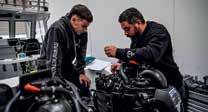
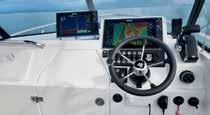








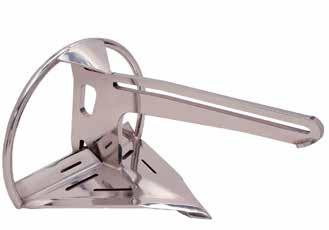
know it’s on. At speed the sound is amazing – it sounds powerful but never loud or annoying. The Advanced MidSection (AMS) on Verado engines greatly reduces noise and vibration, which all adds to an amazing experience in this boat.
I opted for Mercury’s power steering, which greatly helps the ride and performance experience as everything is smoother and more responsive, and coupled with fly-by-wire controls there is nothing clunky or mechanicalfeeling. I also installed Mercury’s tilt helm, which ensures I always have a comfortable driving experience whether I’m sitting or standing.
There are little things about the Mercury that make fishing and boating more enjoyable. A 115amp alternator keeps an extensive light and electronic package fully charged. Mercury’s Troll Control feature is excellent for


controlling speeds as it lets you digitally set your RPM via your MFD or Vessel View when trolling, allowing you to achieve slower speeds than are achievable via the binnacle. Mercury integrates perfectly with the Simrad system equipped on the boat and one great feature is a dimmer switch for the Simrad units, so if you’re driving and the sun goes down or up you can easily adjust it without taking your hand off the binnacle. When you’ve turned the screen brightness all the way down at night, and when you jump back in the boat the next day, you’re not scrambling to find the brightness dial on a black screen. It’s all very well thought-out and intelligent.
Next month we’ll have the full rundown on the trailer and the electronics and lighting package we installed on the boat – it’s extensive and has some great new products on it.







High Quality customised switch panels
We can make any configuration for any boat whether second hand or brand new
Contact us today to for a quote for your dream vessel





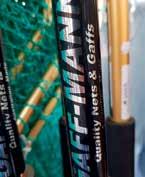
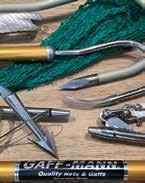
The Demon is a straight running lure that features our widest range of 8 different size s. The hydrodynamic head shape, combined with the cone shaped nose profile, gives the Demon its enticing action that no predatory fish can resist. The Demon is highly effective on both billfish and tuna and is a must have in your lure wrap. With a huge running speed from of 6 - 14 knots, the Demon is the perfect all-rounder in every position on the boat.


Words & Images: Kosta Linardos
We are spoiled for choice when it comes to reels from Shimano, whose range of reels is better than ever – and every three to four years as we get a model update that makes the reels significantly better. I know many accomplished anglers happily using the Nasci and Saragosa models, which sit at the lower end of Shimano’s mid-range reels. Therefore, the focus of reviews is now less about testing them for faults and issues (which we still do) and more about finding the best use for a new model and explaining why to the reader.
In the time I’ve been using Stradics (about 15 years) I’ve used them as general purpose bait fishing and squid reels, with the exception of the CI4 models which I use for lures. It’s not
that they’re not a great reel for lure fishing (they are, and this model is the best yet), but they’ve always been an ultra-reliable and durable utility reel that years down the track feels as good as the day you bought it.
When it comes to marketing, bait fishing isn’t as sexy as lure fishing and almost all reels use marketing content with lure fishing images and videos. However, most anglers are bait fishermen – and bait reels get a lot of abuse. I’ve spent just over six months testing the Stradic FM 3000c heavily. It’s been on an egi road targeting squid on every trip since November and on every whiting trip, two species I target often. It’s literally caught hundreds of whiting, hundreds of big squid
and multiple big cuttlefish. The same rod I use for squid I also use for bait collecting, so it’s caught countless Australian salmon, big pike, couta, yakkas, slimies and fought all manner of bycatch such as rays, banjo sharks, big leatherjacket and countless pinkies.
This reel has constantly had its gears worked, has occasionally had its drag worked at high pressure and is regularly exposed to excessive salt, slime and grime through these messy styles of fishing. It is used frequently and catches fish frequently. When I come home I just hose it down with a light spray from the hose, give it a shake, let it drip dry and then once a month I wipe it down with Salt-Away.
It’s still as good as the day Shimano sent it to me for review.
Stradics have always been tough and reliable, and this new FM series is even better. It’s a high gear reel with a ratio of 5.8:1, making it highly versatile thanks to its fast retrieve speed, yet it doesn’t sacrifice torque and lowend grunt. Shimano’s MicroModule II cold forged Hagane gears are tough, smooth and ultra-durable. This is what I’m looking for in a reel – smooth, tough and durable.
The FM features the new Anti-Twist Fin, which is a small elastic rubber fin that sits near the line roller. It’s designed to prevent loose line falling and wrapping over the lower part of the spool. This is something I often experience when squid fishing as I’m always releasing the bail to let the jig sink and then winding up slack line. The Anti-Twist Fin works very well at preventing this from happening.
Another new feature for the Stradic is Dura Cross Drag, made using different fibres in the washers to increase durability of the drag. This isn’t something I noticed while fishing, aside from the fact the drag was always smooth and didn’t falter after seven months of rigorous use.
The main upgrade to the Stradic FM is Infinity Drive, a structure that supports the main shaft and increases torque while keeping winding light and fluid.
I should also note that while the Stradic is built tough with a Hagane body, it’s still a sensitive reel where I am able to detect small finicky bites from fish like whiting.
Just because I’m catching squid and whiting and using bait, doing what’s considered simple fishing, it doesn’t mean I’m looking to sacrifice feel and performance, or strength



and durability, and the Stradic FM offers both in spades. I want to enjoy each fight and each cast and I don’t want to be concerned about whether the reel will last me years of regular use and salt exposure – and that’s what this reel offers. It’s a work horse that drives like a Porsche with the reliability of a LandCruiser.
At $389 it offers great bang for buck. It’s priced in a similar range to the Vanford ($415), which I prefer to use throwing lures to bream, perch and trout. But for regular heavy saltwater use, the Stradic is the better choice.

I dont think anyone can deny it’s one of the best looking reels in existence.
It’s fair to say that Daiwa’s LT (Light and Tough) range of reels has revolutionised the light tackle market. These reels have become smaller, lighter and stronger, which has allowed anglers to present finessed offerings to large fish and land them with greater success than ever before.
While these design and manufacturing advancements were established with reels in the higher price range of Daiwa’s reels such as Certate, they’re now being brought down to more affordable offerings such as the new KIX which I have been sent for review.
The Daiwa 23 KIX is one of the latest reels to hit Daiwa’s light tackle range. However,
unlike other models, it seems to fit within an affordable price range, have a great aesthetic and feature high-end, expensive components that on spec make this reel an exceptional product.
The KIX is available in models ranging from a 2000D to 5000D-C, with prices starting from $299. The smallest model in the range contains an excessive 5kg of drag, while the larger models have 10kg and 12kg of drag respectively.
The KIX features several of Daiwa’s iconic features, such as MAGSEAL, Metal Alloy Body, Tough Digigear, ABS Long Cast and Automatic Tournament Drag.
However, the main feature of the new 23 KIX is the addition of Daiwa’s Airdrive design. This design improvement is seen in Daiwa’s high-end light tackle reels, such as the Airity and Certate. Airdrive technology reduces the overall weight of the reel while increasing the smoothness of the reel by reducing resistance.
The new KIX also has a completely different aesthetic from its predecessor and any other reel on the market with a dark green body combined with a black and gold spool. It retains the round EVA knob and this coupled with it’s 5kg of drag tells me its been designed to put the hurt on big fish. While some anglers may not be concerned with the aesthetics of a reel, I think you need to stop
and appreciate it, and in my opinion this is the best-looking reel Daiwa has produced since the 2015 Daiwa Exist.
A completely new feature for the KIX is a guard on top of the line roller, the name of this part translates from Japanese to Anti Tangle Roof. It’s a feature I’ve never seen on a Daiwa reel before but going forward all reels fitted with Daiwa’s new Air Drive Wire Bail will feature it. It’s designed to prevent loose line wrapping around the bail hinge, it’s not something that happens often, and less so with experienced anglers, however, in windy conditions where slack line is at play it can and does happen. The Anti Tangle Roof is for added security to aid line management. This then brings me to Daiwa’s new wire bail. For years anglers have lauded Daiwa’s Air Bail, a thick yet hollow bail wire and a signature design and recognisable aesthetic of their light tackle reels, however, the new Air Drive Wire Bail implemented on the KIX, Daiwa claims is stronger and lighter than the old Air Bail regardless of the fact it’s thinner.
We were sent the 2000D model to review, the smallest reel in the range. This model would be the perfect example to test whether this reel is truly a ‘light tackle, heavy duty’ reel.
On a recent trip, I was targeting snapper around pylons and jetties on Daiwa Wave Minnows. Fishing with tight drag on a light reel was sure to test the durability and strength of the KIX, and after catching several smaller snapper to 40cm, I tussled with three larger fish up to 2kg.


I have no doubt I pushed this reel to its limits after fighting well over 30 snapper for the day. The Automatic Tournament Drag (ATD) didn’t slip and maintained constant pressure during the fight, while the reel stem and body never felt like it was flexing, even when placed under heavy drag to pull snapper away from structure.

The 23 KIX performs just as well on the water as it does straight out of the box. This is something that you would expect of all reels, but unfortunately not all light tackle reels feel as good winding under duress as they do in a tackle shop.
The reel is built tough enough to tackle snapper on soft plastics while possessing enough finesse to keep small hooks in garfish. If you’re in the market for a new light tackle reel, you’ll be hard-pressed to find a better reel at this price.
Words & Images: Stuart Pentin



When it comes to outfits for sword fishing, precision and reliability are paramount. This is a fish where we’re making a 200km round trip and there’s no guarantee we’ll even get a bite. I therefore take gear and preparation for this style of fishing very seriously.
Hooked Up’s Kosta recently sent me a few Meridian Sword Skirts to review. What I instantly liked about them is they are purpose-designed for placing over baits and targeting swordfish, whereas I have always used lure skirts which weren’t ideal. These skirts are tailored specifically to the needs of sword fishermen.
One of the most striking features of these skirts is their innovative design. Unlike anything else on the market, the wider head simplifies the rigging process, accommodating both J-hooks and circle hooks with ease. Whether you’re a seasoned sword angler or new to targeting these deep water beasts, you’ll appreciate the convenience and efficiency these skirts bring to the rigging process.
It’s not just about ease of rigging; it’s also about presentation. The streamlined shape of these skirts ensures your bait is presented in the most enticing manner possible.
Durability is another area where these skirts excel. Whether you’re pushing a belly flap into them or stitching wax thread, you’ll be impressed by their resilience. Unlike other skirts on the market that may tear or fray under pressure, these skirts hold up well.
And let’s not forget their visual appeal. While some anglers may be indifferent to the colour of their skirts, the Meridian Sword Skirts offer a range of options to suit every preference. Moreover, their glow-in-the-dark feature is truly remarkable, providing added visibility in the depths where swordfish lurk. In the dimly lit underwater world, a little extra glow can be the difference between a strike and a missed opportunity.
For those rigging baits on circle hooks, a valuable tip: consider securing a bead on the inside of the skirt with wax thread. This simple technique adds an extra layer of security, ensuring your skirt stays firmly in place during the heat of battle. When you’re locked in a fierce struggle with a powerful swordfish, the last thing you want to worry about is your gear failing you. With this precaution in place, you can focus on the task at hand with confidence and determination.
Ultimately, when you’re dropping bait down 400 to 500 metres, you need gear that you can rely on without hesitation. With the limited opportunities afforded by a day of sword fishing, there’s little room for doubt or uncertainty. That’s where the Meridian Sword Skirts truly shine. With their innovation, durability and performance, they’re a better choice when rigging baits for swordfish where you need nothing less than the best.

take it everywhere, do everything!
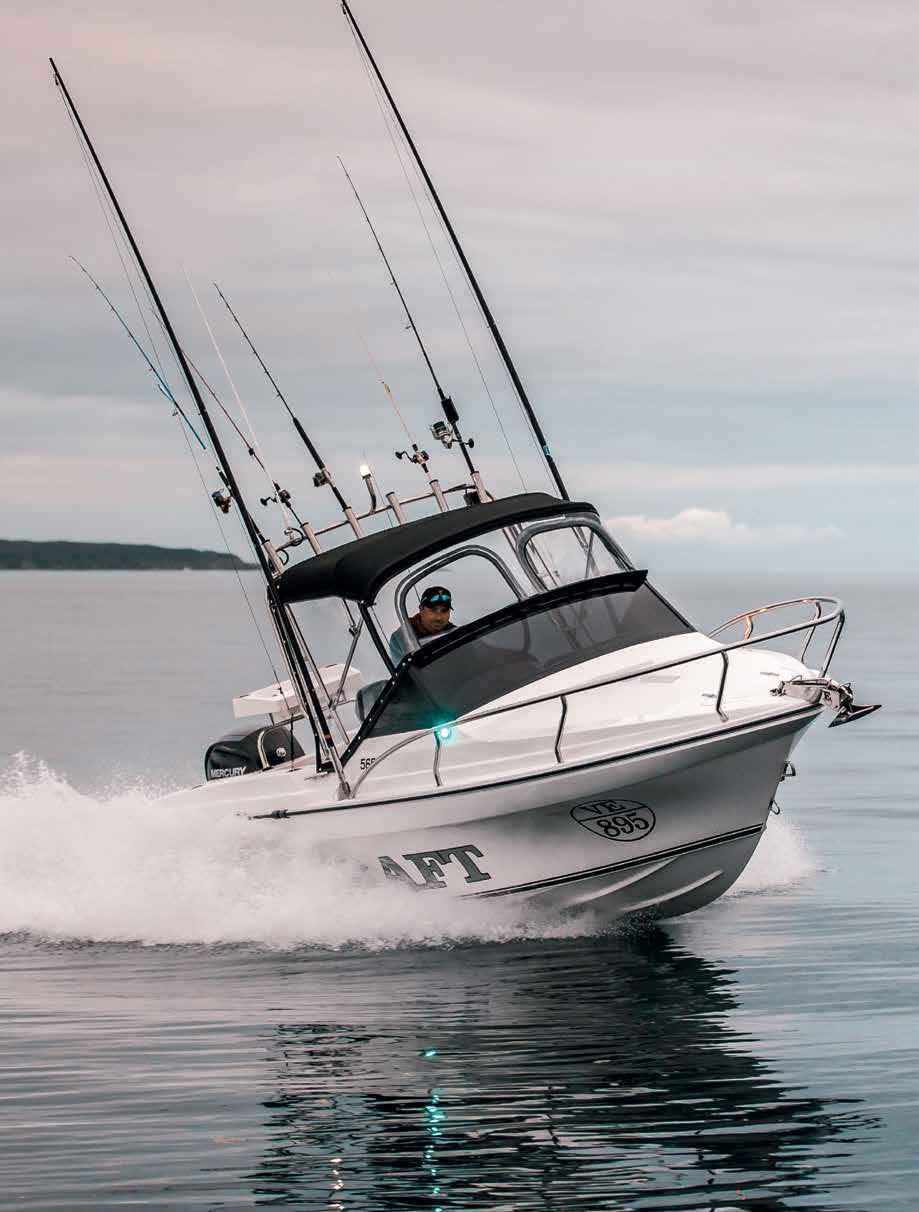



WITH MERCRUISER – BUILT TO PERFORM, BUILT TO LAST, BUILT TO ENJOY
Mercury MerCruiser engines and drive systems are designed, tested, and purpose built for the marine environment.
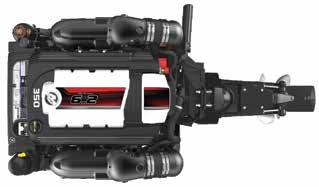

POWERFUL - High displacement delivering more torque
FUEL EFFICIENT - Providing extended range
DURABLE & RELIABLE - Complete peace of mind
Go online or see nearest Mercury Dealer to discuss powering your time on the water.
